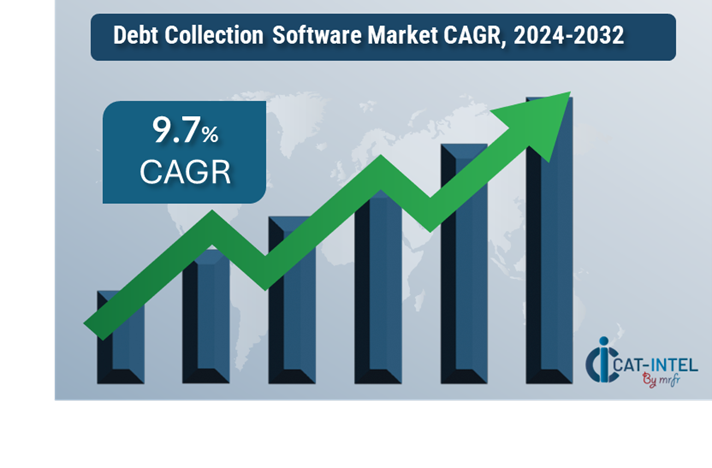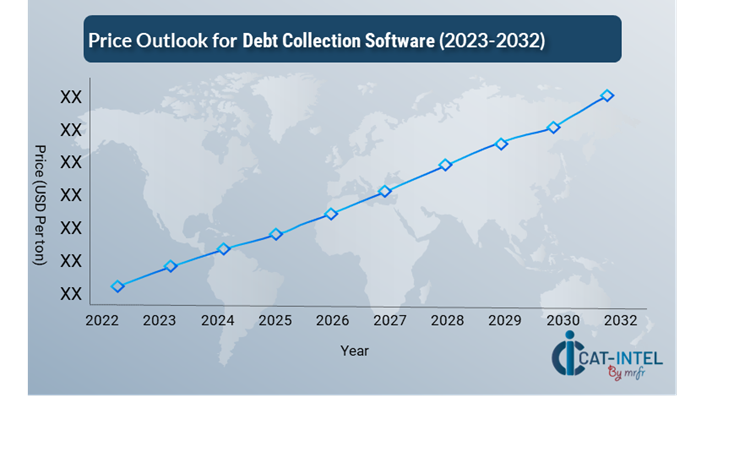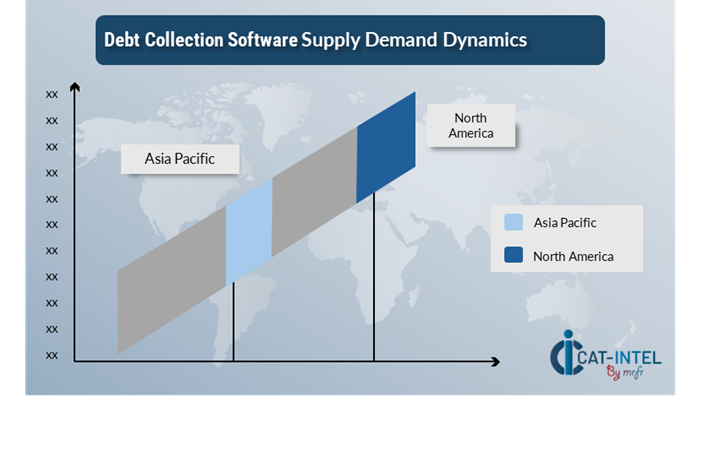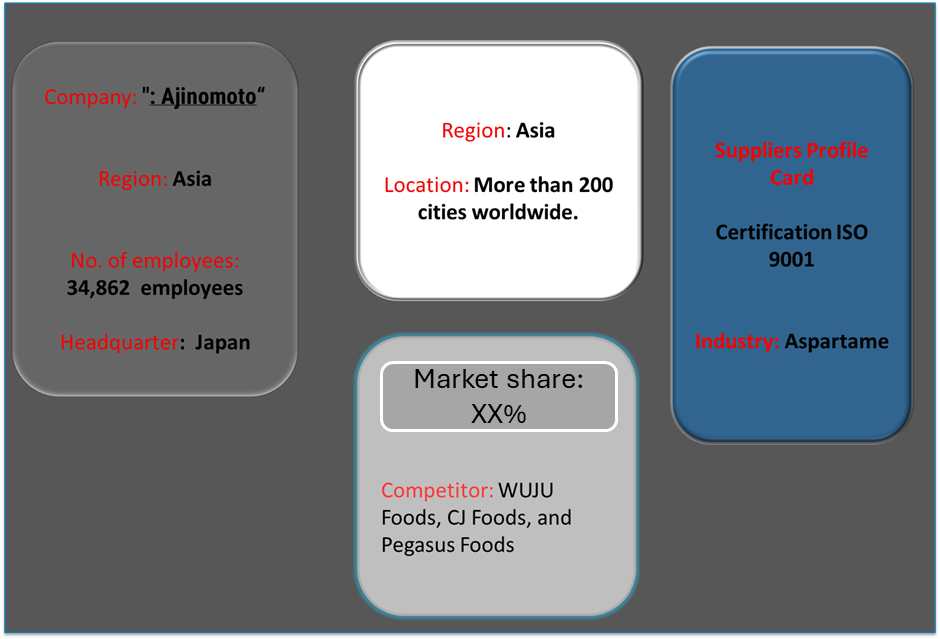Debt Collection Software Market Overview:
The global debt collection software market is experiencing steady growth, driven by the increasing demand for efficient and automated solutions to manage debt recovery processes across various industries. This market includes software that automates the collection of overdue accounts, streamlines communication with debtors, and enhances reporting and analytics. Our report provides an in-depth analysis of procurement trends, focusing on cost optimization, the adoption of digital tools, and the improvement of risk management practices in debt recovery.
Key future challenges in debt collection software procurement include managing fluctuating regulatory requirements, maintaining data security, and integrating AI-driven technologies for enhanced collection strategies. As the need for efficient debt recovery continues to rise, organizations are increasingly leveraging market intelligence to optimize their software procurement strategies and mitigate associated risks.
The debt collection software market is expected to maintain consistent growth through 2032, with key highlights including:
- Market Size: The global debt collection software market is projected to reach USD 9585.63 billion by 2032, growing at a CAGR of approximately 9.7% from 2024 to 2032.

- Sector Contributions: Growth in the market is driven by:
- Financial Services Demand: Increasing need for robust software solutions to handle growing accounts receivable portfolios and enhance the recovery process.
- Telecom and Utility Sector Growth: Rising adoption of automated debt collection systems for improving customer service and accelerating payment recovery.
- Technological Transformation: Integration of AI, machine learning, and automation in debt collection processes, enhancing performance and reducing manual efforts.
- Innovations: Development of omnichannel communication tools and automated payment scheduling systems to improve customer engagement and recovery rates.
- Investment Initiatives: Companies are investing in cloud-based platforms, offering scalability and flexibility for debt recovery systems.
- Regional Insights: North America and Europe are major contributors due to high regulatory standards and a strong demand for efficient debt management solutions.
Key Trends and Sustainability Outlook:
- Digital Integration: Cloud-based debt collection software is becoming increasingly popular due to its scalability, cost-effectiveness, and ease of integration with existing financial systems.
- Automation and AI: AI-powered debt collection solutions are reducing the reliance on manual processes and improving recovery rates by predicting the likelihood of successful collections.
- Regulatory Compliance: Debt collection software solutions are being enhanced to comply with evolving global data protection laws and consumer protection regulations.
- Data-Driven Insights: Advanced analytics and reporting features are being integrated into debt collection software to provide actionable insights into payment trends and debtor behavior.
- Focus on Customer Experience: Solutions that offer personalized communication methods and flexible payment options are gaining popularity as businesses aim to maintain positive relationships with debtors.
Growth Drivers:
- Expansion of Financial Services: As the financial sector grows, so does the demand for debt collection software to handle increasing volumes of overdue accounts.
- Telecom and Utilities: The growth of telecom and utility services has driven the need for automated and efficient debt recovery solutions to manage large-scale debt portfolios.
- Regulatory Compliance: The need to adhere to stringent regulations around data privacy, collection practices, and consumer rights is propelling the adoption of compliant debt collection software.
- AI and Automation: Adoption of AI-driven debt collection strategies is streamlining processes, reducing operational costs, and improving overall recovery performance.
- Sustainability Goals: As organizations strive for more sustainable business practices, there is growing interest in cloud-based, energy-efficient debt collection solutions.
Overview of Market Intelligence Services for the Debt Collection Software Market:
Recent market analyses have highlighted key challenges such as fluctuating regulatory requirements and the need for highly customizable debt recovery solutions. Market intelligence reports provide actionable insights into procurement opportunities, helping organizations identify cost-saving measures, optimize supplier management, and ensure compliance with industry regulations. These insights enable businesses to manage risks effectively, improve operational efficiency, and implement best practices in debt recovery.
Procurement Intelligence for Debt Collection Software: Category Management and Strategic Sourcing:
To stay competitive in the debt collection software market, businesses are enhancing procurement processes through spend analysis, supplier performance tracking, and effective contract negotiations. Category management and strategic sourcing are essential for reducing procurement costs while ensuring access to high-quality software solutions. By leveraging actionable market intelligence, organizations can optimize their procurement strategies and negotiate favourable terms for their debt collection software needs.

Pricing Outlook for Debt Collection Software: Spend Analysis
The pricing outlook for debt collection software is expected to remain moderately stable, with potential fluctuations driven by key factors. Changes in technology advancements, regulatory requirements, and demand for customization and AI-based features will influence price trends. Additionally, increasing demand for cloud-based solutions, as well as the integration of machine learning and automation, may contribute to upward price pressures.

Graph shows general upward trend pricing for debt collection software and growing demand. However, there may be fluctuations influenced by economic conditions, technological advancements, and competitive dynamic.
Efforts to streamline procurement processes, optimize vendor management, and implement cost-effective technologies are essential for controlling expenses. Leveraging market intelligence tools for pricing monitoring, forecasting, and efficient software lifecycle management can further enhance cost management.
Partnering with reliable software vendors, negotiating long-term contracts, and adopting modular or scalable solutions are key strategies to manage debt collection software pricing effectively. Despite these challenges, maintaining software performance, ensuring regulatory compliance, and integrating advanced analytics will be crucial for sustaining cost efficiency.
Cost Breakdown for Debt Collection Software: Total Cost of Ownership (TCO) and Cost-Saving Opportunities

- Licensing and Subscription Fees (40%)
- Description: A significant portion of the total cost is related to licensing or subscription fees for the debt collection software. These fees vary based on the size of the organization, the number of users, and the functionality of the software, such as advanced AI features, cloud integration, and customer support.
- Trends: Companies are shifting towards subscription-based pricing models or SaaS (Software as a Service) offerings, which provide flexibility and scalability. Some vendors offer tiered pricing, with higher costs for premium features like AI-powered analytics or real-time debt recovery tracking.
- Implementation and Setup Costs (XX%)
- Data Security (XX%)
- Maintenance and Support (XX%)
Cost-Saving Opportunities: Negotiation Levers and Purchasing Negotiation Strategies
In the debt collection software industry, optimizing procurement processes and employing strategic negotiation tactics can significantly reduce costs and improve software efficiency. Establishing long-term agreements with software vendors, particularly in key production regions or markets, can lead to better pricing and favourable terms, such as volume discounts, bundled services, or extended support contracts. Additionally, opting for subscription-based or cloud-based models may help reduce upfront costs and offer greater flexibility.

Bulk purchasing or bundling multiple software licenses together, as well as negotiating forward contracts or long-term commitments, can secure lower rates and protect against potential price increases. Working with vendors that prioritize innovation and customization may offer further benefits, such as access to cutting-edge features like AI-powered collections or improved data analytics capabilities.
Adopting digital tools for vendor management and incorporating strategic sourcing practices, such as demand forecasting and spend analysis, can also improve negotiation outcomes. Diversifying software vendors and employing a multi-supplier strategy can help mitigate risks such as service disruptions, software downtimes, or data security issues, providing leverage during contract negotiations.
Supply and Demand Overview for Debt Collection Software: Demand-Supply Dynamics and Buyer Intelligence for Effective Supplier Relationship Management (SRM)
The debt collection software market is growing steadily, driven by increasing demand for automated and AI-driven solutions across industries such as financial services, telecommunications, utilities, and healthcare. The balance between supply and demand is influenced by factors such as technological advancements, regulatory requirements, and the growing need for compliance in debt recovery processes.
Demand Factors:
- Financial Services and Collections Growth: The increasing need for efficient debt recovery in sectors like banking and insurance is pushing demand for robust debt collection software.
- Regulatory Compliance: Stricter regulations around data privacy and debt collection practices are driving demand for software solutions that ensure compliance with local and global laws.
- Automation and AI Adoption: As organizations move toward automation, there is greater demand for software that integrates AI, machine learning, and predictive analytics to optimize debt recovery strategies.
- Customization Needs: The need for debt collection software tailored to specific industries (e.g., healthcare, utilities) or use cases (e.g., omnichannel communication) is increasing, leading to demand for customized software solutions.
Supply Factors:
- Technology Advancements: Innovations in AI, machine learning, and cloud computing have significantly enhanced the capabilities of debt collection software, improving functionality and cost-effectiveness.
- Vendor Landscape: The number of software vendors is growing, and competition in the market is driving continuous innovation and pricing options, making it easier for buyers to choose between alternatives.
- Regulatory Standards: Software vendors must adapt to various regional regulations, such as GDPR in Europe and the Fair Debt Collection Practices Act in the U.S., impacting the development and availability of compliant debt collection software.
- Software Integration: As more businesses adopt integrated enterprise systems (e.g., CRM, ERP), demand for debt collection software that seamlessly integrates with these platforms is increasing.
Regional Demand-Supply Outlook: Debt Collection Software

The Image shows growing demand for Debt Collection Software in both North America and Asia Pacific, with potential price increases and increased Competition.
North America: Dominance in Debt Collection Software
North America in US, Canada and Mexico is a dominant region in the debt collection software market due to several factors:
- Regulatory Compliance: Strict regulatory requirements in the U.S. and Canada, such as the Fair Debt Collection Practices Act (FDCPA) and GDPR compliance, create a strong demand for sophisticated and compliant debt collection solutions.
- Financial Services and Debt Recovery Growth: With the U.S. being a hub for financial services, insurance, and healthcare, there is growing demand for automated debt collection software solutions to manage large volumes of debt and streamline collections.
- Technological Advancements: North America leads in the adoption of AI, machine learning, and cloud-based platforms, driving the development of more efficient, automated debt collection solutions.
- Vendor Competition: The region is home to several leading debt collection software vendors, fostering a competitive environment that encourages innovation and provides businesses with multiple software options.
- Focus on Consumer Protection: The increasing focus on consumer rights and data privacy is driving the demand for software solutions that align with consumer protection laws while ensuring optimal debt recovery processes.

North America Remains a key hub Debt Collection Software price drivers Innovation and Growth.
Supplier Landscape: Supplier Negotiations and Strategies
The supplier landscape for debt collection software is diverse and competitive, with a mix of global and regional vendors offering a variety of solutions to meet the growing needs of businesses across industries. These software vendors significantly influence key factors such as pricing, feature innovation, compliance with regulations, and customer service quality. The market is led by established companies providing comprehensive, out-of-the-box solutions, while smaller, specialized vendors cater to niche markets with tailored software solutions or industry-specific functionalities.
As demand for automated debt collection solutions grows across sectors like financial services, utilities, and telecommunications, suppliers are enhancing their product offerings, integrating advanced technologies such as artificial intelligence (AI), machine learning, and cloud-based solutions. Many vendors are also prioritizing regulatory compliance, data security, and sustainability to deliver reliable, cost-effective, and compliant solutions.
Key Suppliers in the Debt Collection Software Market Include:
- FICO
- Experian
- DebtPayPro
- Kata bat
- True Accord
- Optio Solutions
- Chetu
- Collect One
- CoreLogic
- GIACT Systems

Key Developments Procurement Category Significant Development:
|
Significant Development |
Description |
|
Market Growth |
The debt collection software market is experiencing steady growth, driven by increasing demand across industries like finance, utilities, and telecommunications, as businesses seek automation and efficiency in their collections processes. |
|
Sustainability Focus |
There is a growing emphasis on data privacy and compliance, with debt collection software developers focusing on secure and compliant solutions to adhere to regulations such as GDPR and PCI DSS. |
|
Product Innovation |
Software vendors are diversifying their offerings by integrating advanced features such as AI-driven predictive analytics, automated customer engagement, and self-service portals for debtors. |
|
Technological Advancements |
Innovations in debt collection software include the use of artificial intelligence, machine learning for predictive analytics, and cloud-based solutions to enhance scalability and reduce operational costs. |
|
Global Trade Dynamics |
Changes in global regulatory standards, such as debt collection laws in different regions, are influencing software features and compliance needs, requiring vendors to adapt to diverse legal landscapes. |
|
Customization Trends |
There is increasing demand for customizable debt collection software that can be tailored to specific industries, such as healthcare, telecommunications, or retail, to meet unique collection challenges and regulatory requirements. |
|
Debt Collection Software Attribute/Metric |
Details |
|
Market Sizing |
The global debt collection software market is projected to reach USD 9585.63 billion by 2032, growing at a CAGR of approximately 9.7% from 2024 to 2032. |
|
Software Technology Adoption Rate |
Around 55% of companies are adopting advanced debt collection software solutions, integrating artificial intelligence (AI) and machine learning (ML) for improved efficiency and predictive analytics. |
|
Top Debt Collection Software Strategies for 2024 |
Key strategies include adopting AI-driven solutions for automated collections, improving customer experience through multi-channel communication, enhancing data security and regulatory compliance, and integrating cloud-based platforms for scalability. |
|
Software Process Automation |
Approximately 45% of debt collection software vendors have implemented automation in collections processes, such as automated payment reminders and dispute management, to reduce manual intervention and improve accuracy. |
|
Software Process Challenges |
Major challenges include managing data security and privacy, ensuring compliance with varying regional debt collection laws, overcoming customer resistance to automated collections, and addressing integration issues with existing enterprise systems. |
|
Key Suppliers |
Leading suppliers in the debt collection software market include FICO, Experian, and Katabat, offering diverse solutions for debt recovery, risk management, and customer engagement. |
|
Key Regions Covered |
Prominent regions for debt collection software adoption include North America, Europe, and Asia-Pacific, with significant demand in sectors like finance, telecommunications, and utilities. |
|
Market Drivers and Trends |
Growth is driven by the need for efficient debt recovery solutions, increasing demand for automation in financial processes, regulatory compliance requirements, enhanced customer experience through omnichannel strategies, and the shift towards cloud-based software. |
Frequently Asked Questions (FAQ):
A1: Our procurement intelligence services provide detailed market analysis, identifying leading debt collection software providers and evaluating industry trends. We offer spend analysis, supplier evaluations, and sourcing strategies to help secure reliable software vendors at competitive prices.
A2: We assist in assessing the TCO by factoring in software licensing costs, implementation expenses, training fees, ongoing support, and updates. This comprehensive analysis helps you understand the overall financial impact of adopting debt collection software.
A3: Our risk management services address challenges such as data security, regulatory compliance, integration issues, and software scalability. These strategies ensure a secure and cost-effective software procurement process.
A4: Our Supplier Relationship Management (SRM) services focus on building strong partnerships with debt collection software vendors. We assist in contract negotiations, track vendor performance, and ensure smooth integration into your operations.
A5: We recommend best practices such as defining clear software requirements, performing cost-benefit analysis, evaluating vendor support capabilities, and ensuring data security compliance. These practices help streamline the procurement process and ensure effective software adoption.
A6: Digital tools enhance the procurement of debt collection software by automating contract management, improving vendor communications, and offering data-driven insights to optimize software selection and implementation processes.
A7: Our supplier performance management services track critical metrics such as software uptime, customer support response time, and software updates. This ensures that vendors consistently meet performance expectations.
A8: We help negotiate advantageous terms by leveraging market insights, conducting cost benchmarking, and utilizing strategies such as volume discounts, long-term contracts, and flexible payment options.
A9: We offer tools that provide insights into pricing trends, software capabilities, vendor ratings, and customer feedback, enabling data-driven decisions when selecting debt collection software.
A10: We ensure compliance with data privacy regulations (e.g., GDPR, PCI DSS) by verifying that software vendors meet all relevant legal and regulatory standards, ensuring secure and ethical debt recovery practices.
A11: We recommend strategies such as having backup vendors, securing cloud-based solutions, and setting up contingency plans to handle software availability and updates during disruptions.
A12: Our tracking solutions evaluate metrics such as software performance, support efficiency, system uptime, and compliance with SLAs, ensuring reliable vendor performance over time.
A13: We identify software vendors who prioritize energy-efficient operations, cloud solutions with reduced environmental impact, and those who adhere to sustainable business practices.
A14: Our pricing analysis compares software rates, tracks market trends, and applies negotiation techniques to secure cost-effective, high-quality software solutions that meet your organization's needs.











